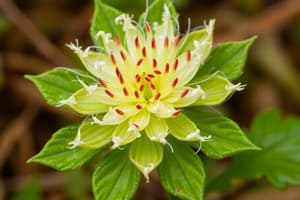Podcast
Questions and Answers
Which taxonomic level comes after family in the classification of plants?
Which taxonomic level comes after family in the classification of plants?
- Class
- Genus (correct)
- Domain
- Species
What is the defining characteristic of the subkingdom Tracheobionta within the Plantae domain?
What is the defining characteristic of the subkingdom Tracheobionta within the Plantae domain?
- Reproducing through spores
- Lacking a vascular system
- Producing seeds in cones
- Having specialized conducting cells called tracheids or vessels (correct)
Which subclass is mentioned to have more than 270 genera in the text?
Which subclass is mentioned to have more than 270 genera in the text?
- Rosidae
- Magnoliidae (correct)
- Cycadidae
- Liliidae
What is the main purpose of alternative classification systems like APG III or Cronquist Systems?
What is the main purpose of alternative classification systems like APG III or Cronquist Systems?
What type of plants fall under the subkingdom Tracheobionta?
What type of plants fall under the subkingdom Tracheobionta?
Why is the taxonomic classification system important for understanding plants?
Why is the taxonomic classification system important for understanding plants?
What are the four divisions within the Plantae domain?
What are the four divisions within the Plantae domain?
What is the alternative name for the division Magnoliophyta?
What is the alternative name for the division Magnoliophyta?
Which classes make up the class Magnoliopsida within the Plantae domain?
Which classes make up the class Magnoliopsida within the Plantae domain?
Which order is NOT part of the class Magnoliopsida?
Which order is NOT part of the class Magnoliopsida?
Which family includes tomatoes and potatoes among its members?
Which family includes tomatoes and potatoes among its members?
What is the main characteristic of Angiosperms?
What is the main characteristic of Angiosperms?
Flashcards are hidden until you start studying
Study Notes
Introduction
The Plant Kingdom is one of five kingdoms recognized by biologists, consisting of over 500,000 species. Plants have been classified into various taxonomic groups based on their features, such as physical traits, reproductive structures, and genetic make-up. This classification system helps us understand how plants are related to each other and provides information about their evolutionary history. In this article, we will explore some aspects of the Plant Kingdom's classification.
Taxonomic Classification of Plants
In the hierarchical Linnaean taxonomy system, plants are categorized under three domains or kingdoms, one of which is the Plantae domain. Within the Plantae domain, there are four phyla or divisions: Bryophyta, Pteridophyta, Gymnospermae, and Magnoliophyta. These divisions are further divided into classes, orders, families, genera, and species.
For example, the division Magnoliophyta (also known as Angiosperms) includes flowering plants with seeds protected by a covering called the ovule wall. It consists of two classes, Liliopsida and Magnoliopsida. Many common plants belong to these two classes, which, together, account for approximately 98% of all living green plants.
Let's consider the class Magnoliopsida as an illustration. It contains three orders: Dipsacales, Lamiales, and Solanales. One well-known family within the order Solanales is Solanaceae, which includes tomatoes and potatoes among its members. Each family can contain multiple genera, such as Solanum genus, which is part of the Solanaceae family.
As you move down the hierarchy from classes to families, genera, and species, the number of organisms increases dramatically due to the vast diversity within the Plant Kingdom. For instance, the Magnoliidae subclass alone has more than 270 genera, which collectively comprise thousands of species.
Subkingdom Tracheobionta
Within the Plantae domain, the subkingdom Tracheobionta is also used for classification purposes. This group is characterized by having specialized conducting cells called tracheids or vessels, which facilitate the movement of water and nutrients throughout the plant body. All vascular plants (those with xylem and phloem tissue) fall under this subkingdom.
Other Classifications
Apart from the traditional Linnaean taxonomy, plants can also be classified using alternative systems like APG III or Cronquist Systems. These systems emphasize different characteristics and relationships between plants, providing alternative perspectives on the classification of the Plant Kingdom.
Conclusion
In summary, the Plant Kingdom is structured through a complex taxonomic classification system that allows researchers to identify and organize plants based on shared characteristics. This hierarchical structure ranges from domains to species, allowing scientists to better understand the relationships between different types of plants. Whether using the traditional Linnaean method or alternative systems, the goal remains the same—to accurately classify and name plants while revealing insights into their evolutionary history and ecological roles.
Studying That Suits You
Use AI to generate personalized quizzes and flashcards to suit your learning preferences.




